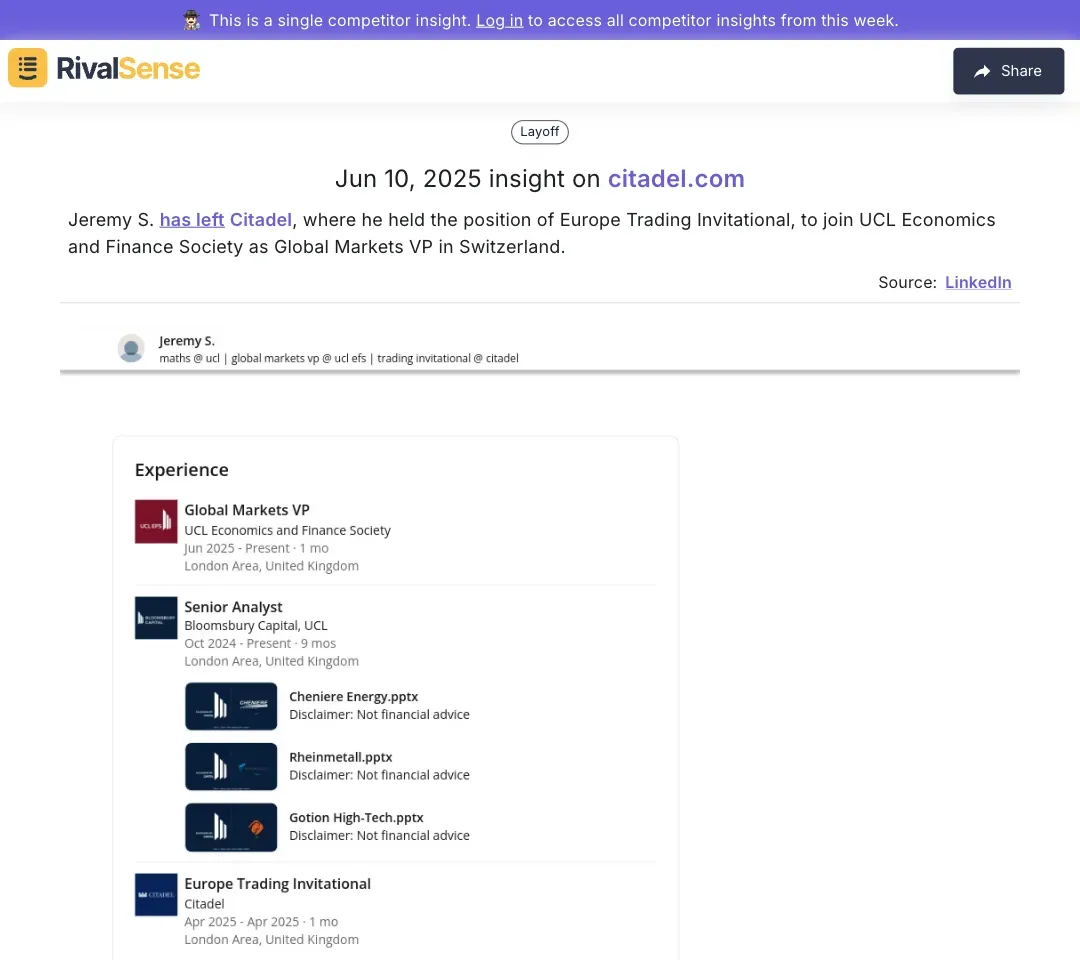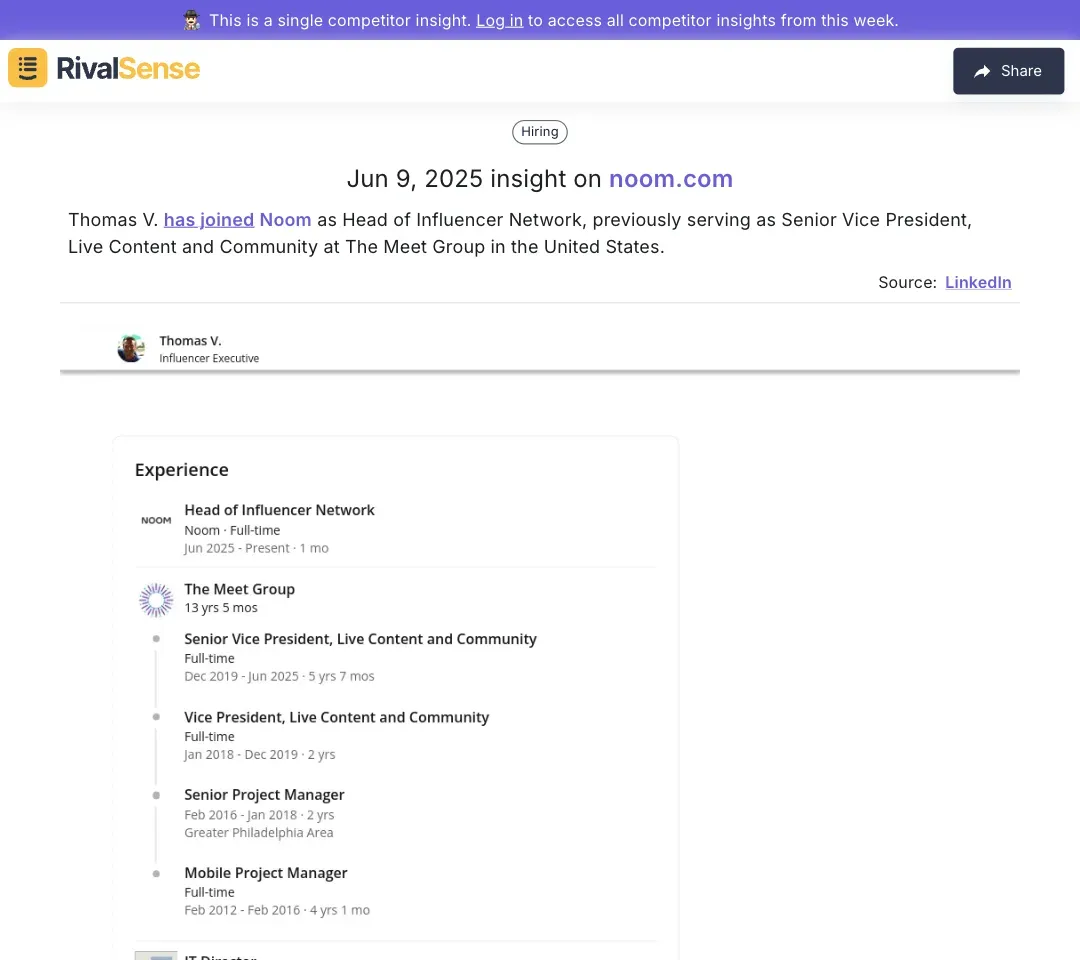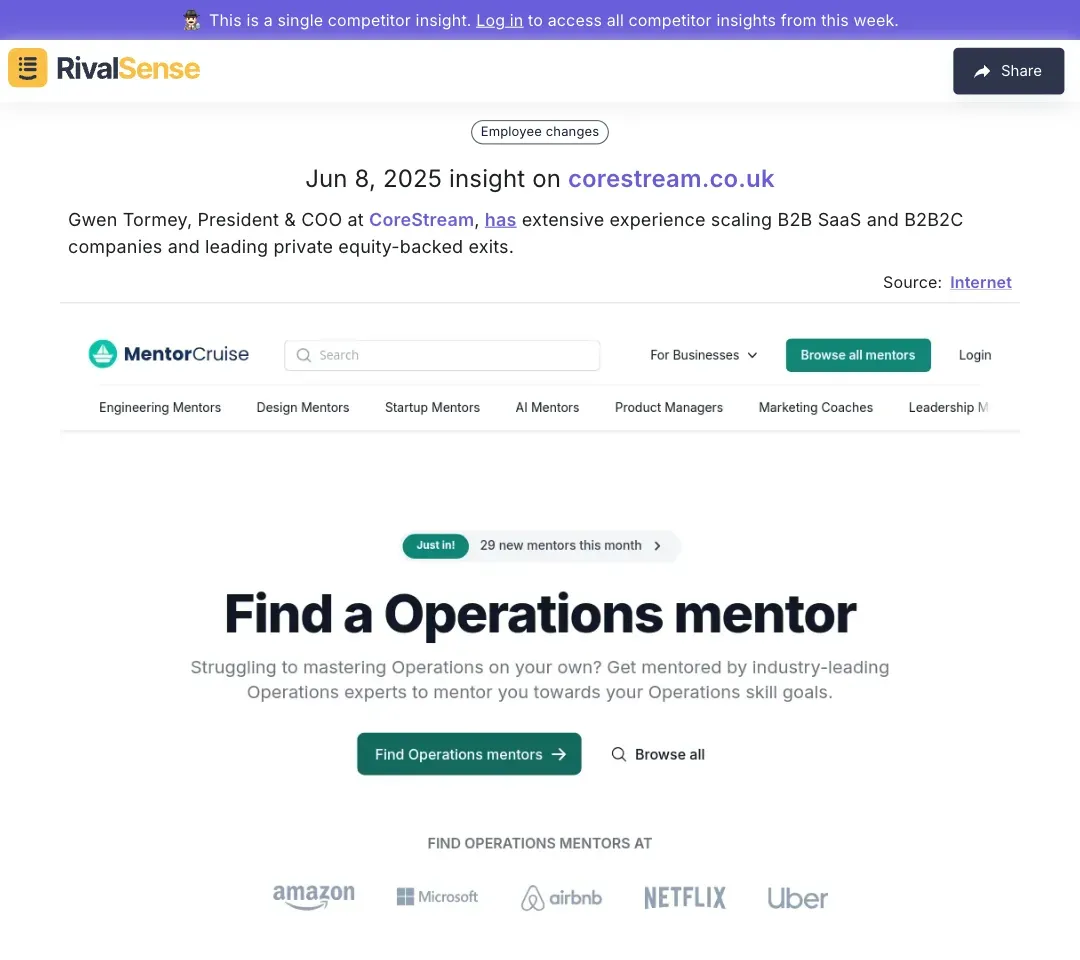How to Track Competitor Hiring and Layoffs for Strategic Insights
In today's hyper-competitive B2B landscape, workforce changes at rival companies serve as powerful indicators of strategic shifts. Tracking hiring spikes or layoffs isn't just corporate gossip—it's mission-critical intelligence that reveals competitors' financial health, market priorities, and innovation pipelines. For founders and CEOs, these signals provide actionable foresight to anticipate threats and opportunities before they materialize in the market.
Key practical applications include:
- 📈 Hiring surges indicating new market entries or product bets
- 📉 Layoff patterns signaling financial stress or strategic pivots
- 👔 Executive movements foreshadowing directional shifts
- 🤖 Automated tracking saving 10+ hours weekly versus manual methods
Integrating these observations lets you adjust pricing, talent acquisition, and R&D allocation proactively—transforming raw data into competitive leverage.
Decoding the Signals from High-Profile Departures
Executive departures often act as early-warning systems for organizational turbulence or strategic redirection. When seasoned leaders exit, it can destabilize product roadmaps, client relationships, and investor confidence. Analyzing where these individuals land reveals cross-industry talent flows and emerging competitive threats.
Consider this real-world scenario tracked through RivalSense:

Jeremy S. left Citadel (Europe Trading Invitational) to join UCL Economics as Global Markets VP in Switzerland. This signals:
- Potential weakening of Citadel's European trading initiatives
- Validation of Switzerland's growing fintech talent pool
- Opportunity to recruit Citadel's displaced talent
Actionable Framework:
- 🕵️♂️ Create departure alerts for VP+ roles at key competitors
- 🔍 Analyze destination patterns: Are exits clustering in specific sectors?
- 💡 Identify vulnerability windows (3-6 months post-departure) for talent poaching
Interpreting New Hires and Their Strategic Implications
Competitor job postings function as public blueprints of their growth priorities. A sudden focus on niche roles—like AI ethics specialists or partnership managers—often precedes market moves by 6-9 months. Savvy CEOs reverse-engineer these hires to forecast competitive threats.
RivalSense recently detected this strategic hire:

Thomas V. became Head of Influencer Network at Noom after leading Community at The Meet Group. This suggests:
- Noom's accelerated investment in community-driven growth
- Shift from pure performance marketing to owned audiences
- Potential B2B2C partnership models emerging
Execution Checklist:
- [ ] Monitor role-specific keywords (e.g., "blockchain," "omnichannel")
- [ ] Track geographic concentration of new positions
- [ ] Cross-reference with patent filings for R&D validation
Learning from Leadership Moves and Industry Shifts
C-suite appointments function as organizational weathervanes, pointing toward future strategic winds. A COO with scaling expertise signals growth mode, while a CFO from distressed-asset backgrounds may hint at restructuring. These moves offer 12-18 month visibility into competitors' trajectories.
Observe this leadership insight captured by RivalSense:

Gwen Tormey (CoreStream President & COO) brings B2B SaaS scaling and PE exit experience. This indicates:
- Preparation for aggressive expansion or acquisition
- Potential vertical specialization in CoreStream's pipeline
- Investor-backed efficiency mandates
Strategic Response Plan:
| Move Type | Your Countermove |
|---|---|
| Growth-focused hire | Audit your scalability bottlenecks |
| Turnaround specialist | Strengthen retention of key accounts |
| Technical leader | Accelerate innovation sprints |
Practical Tools and Techniques for Tracking Workforce Changes
Manual competitor monitoring consumes 15-20% of strategy teams' bandwidth. Effective tracking requires layered approaches combining public data with automation. Focus on signal-to-noise ratio—prioritizing VP+ moves and department-level hiring/layoffs over entry-level churn.
Optimized Toolkit:
- 🔔 Real-time alerts: Google Alerts for "[Competitor] + layoff/hire/restructuring"
- 👥 LinkedIn filters: Track employee count changes and skill additions
- 📊 Benchmarking: Compare hiring velocity against industry health metrics
Weekly Monitoring Framework:
- Monday: Scan executive LinkedIn updates
- Wednesday: Audit competitor career pages
- Friday: Review Glassdoor sentiment shifts
Turning Insights into Action: Strategic Responses to Competitor Moves
Workforce intelligence only creates value when converted into tactical plays. A competitor's R&D team reduction might justify accelerating your innovation cycle, while their sales org expansion could necessitate channel partner fortification. Always map moves to your strategic pillars.
Proven Response Playbook:
- Talent dislocation → Launch targeted recruitment campaigns
- Leadership gaps → Approach their neglected enterprise clients
- New capability hires → Conduct competitive solution teardowns
Example: When SaaS rival CloudCo eliminated its compliance team, SecureCorp immediately:
- Hired two ex-CloudCo compliance specialists
- Launched "Regulatory Peace of Mind" campaign
- Captured 17% of CloudCo's regulated clients within 90 days
🚀 Ready to operationalize these strategies?
Stop manually scouring LinkedIn and news sites. RivalSense delivers curated competitor intelligence—including hiring shifts, leadership changes, and strategic pivots—in a weekly executive briefing. Get your first competitor report today and turn workforce insights into actionable advantage.
📚 Read more
👉 5 Key Business Growth Strategies for 2025: Outperform Your Competitors
👉 Productivity Hacks in Competitor Analysis: Leveraging RivalSense for Strategic Advantage
👉 Decoding JobNimbus' FRSA Event Strategy: What It Means for Competitors
👉 Huel's Flavor Tests: How to Respond to Competitor Product Experiments
👉 Practical Competitive Intelligence for Leadership: A Step-by-Step Guide
